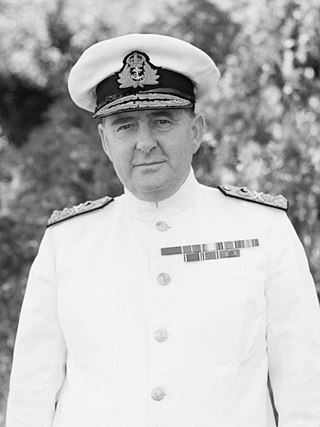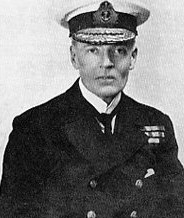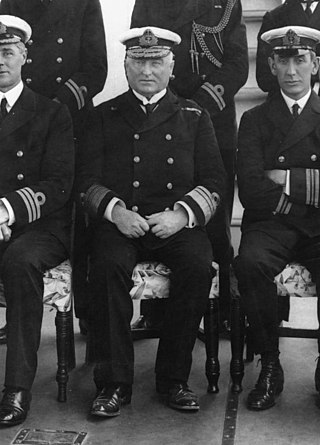
The Home Fleet was a fleet of the Royal Navy that operated from the United Kingdom's territorial waters from 1902 with intervals until 1967. In 1967, it was merged with the Mediterranean Fleet creating the new Western Fleet.
The 5th Battle Squadron was a squadron of the British Royal Navy consisting of battleships. The 5th Battle Squadron was initially part of the Royal Navy's Second Fleet. During the First World War, the Home Fleet was renamed the Grand Fleet.
Admiral Sir William Wordsworth Fisher was a Royal Navy officer who captained a battleship at the Battle of Jutland and became Commander-in-Chief of the Mediterranean Fleet. Arthur Marder wrote that he was "the outstanding admiral of the inter-war period".

Admiral of the Fleet Alfred Ernle Montacute Chatfield, 1st Baron Chatfield, was a Royal Navy officer. During the First World War he was present as Sir David Beatty's Flag-Captain at the Battle of Heligoland Bight in August 1914, at the Battle of Dogger Bank in January 1915 and at the Battle of Jutland in May 1916. After the war he became Commander-in-Chief, Atlantic Fleet and then Commander-in-Chief, Mediterranean Fleet before serving as First Sea Lord in the mid-1930s in which role he won arguments that the Royal Navy should have 70 cruisers rather than the 50 cruisers that had been agreed at the Naval Conference of 1930, that the battleship still had an important role to play despite the development of the bomber and that the Fleet Air Arm should be part of the Royal Navy rather than the Royal Air Force. He subsequently served as Minister for Coordination of Defence in the early years of the Second World War.

Admiral Sir Henry Harwood Harwood, KCB, OBE, was a British naval officer who won fame in the Battle of the River Plate during WWII.

Admiral of the Fleet Sir Frederick Laurence Field, was a senior Royal Navy officer. He served in the Boxer Rebellion as commander of a raiding party and in the First World War as commanding officer of the battleship HMS King George V, flagship of Admiral Martyn Jerram at the Battle of Jutland in May 1916. He went on to be Commander-in-Chief, Mediterranean Fleet before serving as First Sea Lord during the early 1930s, in which role he dealt with the response to the Invergordon Mutiny in September 1931 and ensured the abandonment in 1932 of the 'ten-year rule', an attempt by the treasury to control defence expenditure by requesting the Foreign Office to declare whether there was any risk of war during the next ten years.
The 1st Battle Squadron was a naval squadron of the British Royal Navy consisting of battleships. The 1st Battle Squadron was initially part of the Royal Navy's Grand Fleet. After World War I the Grand Fleet was reverted to its original name, the Atlantic Fleet. The squadron changed composition often as ships were damaged, retired or transferred.

Rear-Admiral Henry Evelyn Charles Blagrove was the first British Royal Navy officer of flag rank to be killed in the Second World War. An experienced staff officer and veteran of several actions of the First World War aboard the battlecruiser HMS Tiger, Blagrove had only just received his appointment as commander of the 2nd Battleship Squadron of the Home Fleet when he was killed in the destruction of his flagship HMS Royal Oak by German submarine U-47.
The 3rd Battle Squadron was a naval squadron of the British Royal Navy consisting of battleships and other vessels, active from at least 1914 to 1945. The 3rd Battle Squadron was initially part of the Royal Navy's Home Fleet. During the First World War, the Home Fleet was renamed the Grand Fleet. During the Second World War, the squadron covered Atlantic convoys.

The 4th Battle Squadron was a squadron of the British Royal Navy consisting of battleships. The 4th Battle Squadron was initially part of the Royal Navy's Home Fleet (1912–14) and then the Grand Fleet after the outbreak of the First World War. The squadron changed composition often as ships were damaged, retired or transferred.

The 3rd Battlecruiser Squadron was a short-lived Royal Navy squadron of battlecruisers that saw service as part of the Grand Fleet during the First World War.

The First Battlecruiser Squadron was a Royal Navy squadron of battlecruisers that saw service as part of the Grand Fleet during the First World War. It was created in 1909 as the First Cruiser Squadron and was renamed in 1913 to First Battle Cruiser Squadron. It participated in the battles of Heligoland Bight, Dogger Bank and the Battle of Jutland. After the end of the war it became the sole Battlecruiser Squadron.

The 2nd Battlecruiser Squadron was a Royal Navy squadron of battlecruisers that saw service as part of the Grand Fleet during the First World War.

Admiral of the Fleet Sir Osmond de Beauvoir Brock, was a Royal Navy officer. Brock served as assistant director of naval intelligence and then as assistant director of naval mobilisation at the Admiralty in the early years of the 20th century. During the First World War Brock commanded the battlecruiser HMS Princess Royal at the Battle of Heligoland Bight and at the Battle of Dogger Bank. He then commanded the 1st Battlecruiser Squadron with his flag in HMS Princess Royal at the Battle of Jutland.

Vice-Admiral Sir Edward Henry Fitzhardinge Heaton-Ellis, KBE, CB, MVO was a British Royal Navy officer.

Admiral Sir Arthur Cavenagh Leveson GCB was a senior officer in the Royal Navy. He was the Rear Admiral Commanding His Majesty's Australian Fleet from 9 January 1917 to 3 September 1918 and later Commander in Chief, China Station from 10 September 1922 to 22 April 1925.

The First Cruiser Squadron was a Royal Navy squadron of cruisers that saw service as part of the Grand Fleet during World War I, then later as part of the Mediterranean during the Interwar period and World War II. It was first established in 1904 and existed until 1952.

Admiral Sir Thomas Henry Martyn Jerram, was a Royal Navy officer who went on to be Commander-in-Chief, China Station.

The Reserve Fleet was a Royal Navy formation of decommissioned vessels which could be brought to a state of readiness at time of war.











